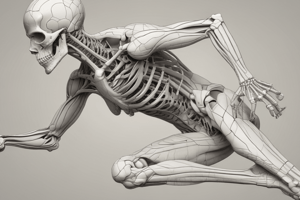Podcast
Questions and Answers
What is gliding?
What is gliding?
Nearly flat bone surfaces slide or glide over each other.
What is flexion?
What is flexion?
Decrease in the angle between bones of a joint, usually occurs on a sagittal plane.
What is extension?
What is extension?
Increase in the angle between bones of a joint; restore to anatomical position.
What is hyperextension?
What is hyperextension?
What is abduction?
What is abduction?
What is adduction?
What is adduction?
What is circumduction?
What is circumduction?
What is rotation?
What is rotation?
What is elevation?
What is elevation?
What is depression?
What is depression?
What is protraction?
What is protraction?
What is retraction?
What is retraction?
What is supination?
What is supination?
What is pronation?
What is pronation?
What is inversion?
What is inversion?
What is eversion?
What is eversion?
What is dorsiflexion?
What is dorsiflexion?
What is plantar flexion?
What is plantar flexion?
Flashcards are hidden until you start studying
Study Notes
Types of Movement at Synovial Joints
-
Gliding: Involves nearly flat bone surfaces that slide or glide over one another, allowing for limited movement.
-
Flexion: A bending movement that decreases the angle between bone segments at a joint, typically occurring in the sagittal plane.
-
Extension: Increases the angle between bones at a joint, often restoring the body part to its anatomical position after flexion.
-
Hyperextension: Refers to excessive extension of a joint, moving beyond the normal anatomical position.
-
Abduction: Movement of a limb or appendage away from the body's midline, increasing the angle with the body.
-
Adduction: Movement towards the midline of the body, decreasing the angle between the limb and the body.
-
Circumduction: A circular movement involving the distal end of an appendage, tracing a circular path while the proximal end remains fixed.
-
Rotation: The pivoting or revolving movement of a body part around a central point or axis.
-
Elevation: An upward movement that raises a body part vertically, like shrugging the shoulders.
-
Depression: The lowering movement of a body part downwards, contrasting elevation.
-
Protraction: The forward movement of a body part on a horizontal plane, moving it anteriorly.
-
Retraction: The backward movement of a body part, drawing it posteriorly along a horizontal plane.
-
Supination: The movement that turns the palm upward or forward, or if the arm is extended, turns the palm upwards.
-
Pronation: The action of turning the palm backward or downwards, including the outward rotation of the arm.
-
Inversion: The movement that turns the sole of the foot inward, elevating the medial edge.
-
Eversion: The action of turning the sole of the foot outward, elevating the lateral edge.
-
Dorsiflexion: Movement that points the toes upwards and stands on the heels, flexing the foot at the ankle.
-
Plantar Flexion: Movement that points the toes downwards, raising the heels off the ground.
Studying That Suits You
Use AI to generate personalized quizzes and flashcards to suit your learning preferences.




